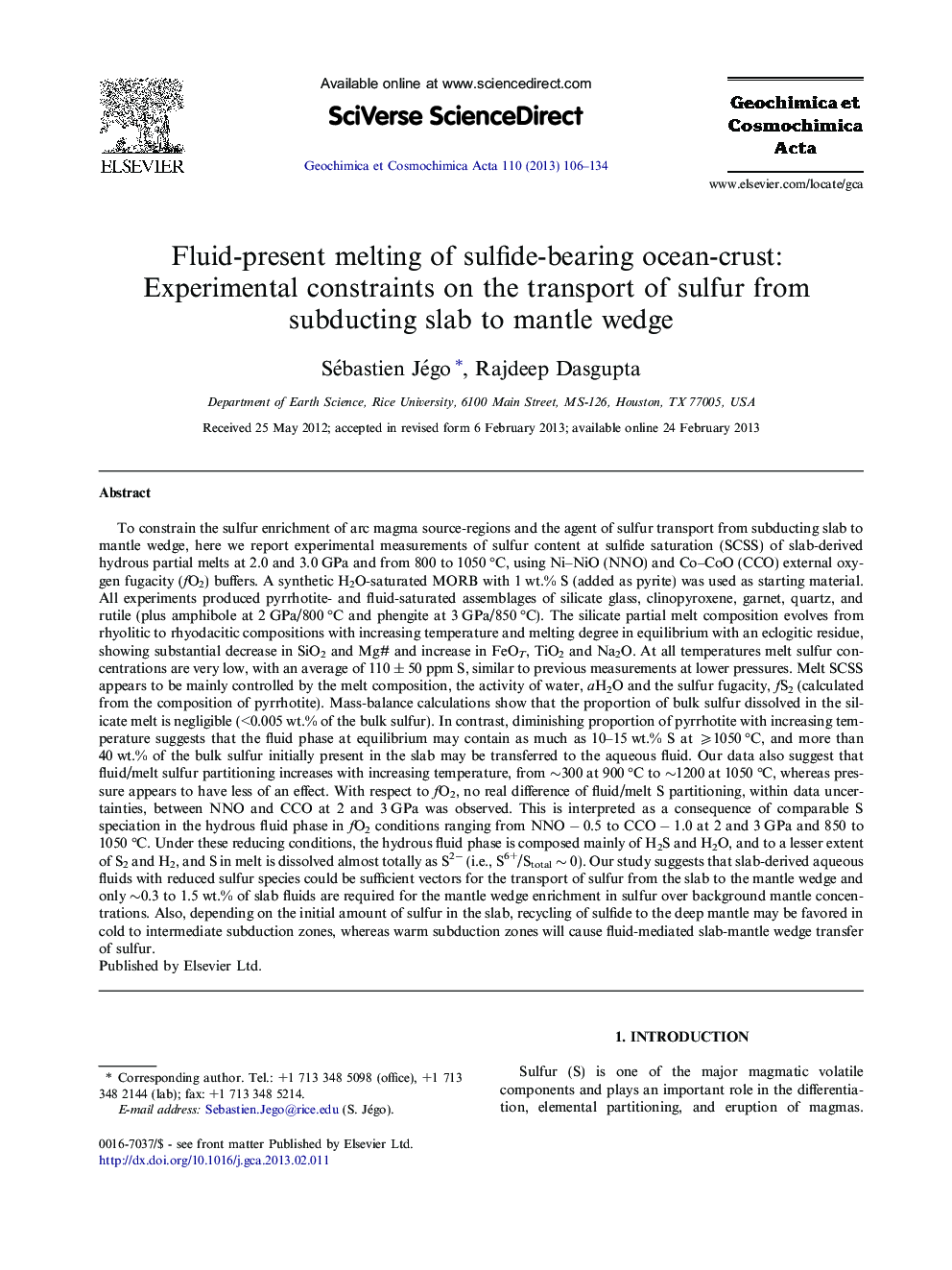| کد مقاله | کد نشریه | سال انتشار | مقاله انگلیسی | نسخه تمام متن |
|---|---|---|---|---|
| 4702487 | 1638047 | 2013 | 29 صفحه PDF | دانلود رایگان |
To constrain the sulfur enrichment of arc magma source-regions and the agent of sulfur transport from subducting slab to mantle wedge, here we report experimental measurements of sulfur content at sulfide saturation (SCSS) of slab-derived hydrous partial melts at 2.0 and 3.0 GPa and from 800 to 1050 °C, using Ni–NiO (NNO) and Co–CoO (CCO) external oxygen fugacity (fO2) buffers. A synthetic H2O-saturated MORB with 1 wt.% S (added as pyrite) was used as starting material. All experiments produced pyrrhotite- and fluid-saturated assemblages of silicate glass, clinopyroxene, garnet, quartz, and rutile (plus amphibole at 2 GPa/800 °C and phengite at 3 GPa/850 °C). The silicate partial melt composition evolves from rhyolitic to rhyodacitic compositions with increasing temperature and melting degree in equilibrium with an eclogitic residue, showing substantial decrease in SiO2 and Mg# and increase in FeOT, TiO2 and Na2O. At all temperatures melt sulfur concentrations are very low, with an average of 110 ± 50 ppm S, similar to previous measurements at lower pressures. Melt SCSS appears to be mainly controlled by the melt composition, the activity of water, aH2O and the sulfur fugacity, fS2 (calculated from the composition of pyrrhotite). Mass-balance calculations show that the proportion of bulk sulfur dissolved in the silicate melt is negligible (<0.005 wt.% of the bulk sulfur). In contrast, diminishing proportion of pyrrhotite with increasing temperature suggests that the fluid phase at equilibrium may contain as much as 10–15 wt.% S at ⩾1050 °C, and more than 40 wt.% of the bulk sulfur initially present in the slab may be transferred to the aqueous fluid. Our data also suggest that fluid/melt sulfur partitioning increases with increasing temperature, from ∼300 at 900 °C to ∼1200 at 1050 °C, whereas pressure appears to have less of an effect. With respect to fO2, no real difference of fluid/melt S partitioning, within data uncertainties, between NNO and CCO at 2 and 3 GPa was observed. This is interpreted as a consequence of comparable S speciation in the hydrous fluid phase in fO2 conditions ranging from NNO − 0.5 to CCO − 1.0 at 2 and 3 GPa and 850 to 1050 °C. Under these reducing conditions, the hydrous fluid phase is composed mainly of H2S and H2O, and to a lesser extent of S2 and H2, and S in melt is dissolved almost totally as S2− (i.e., S6+/Stotal ∼ 0). Our study suggests that slab-derived aqueous fluids with reduced sulfur species could be sufficient vectors for the transport of sulfur from the slab to the mantle wedge and only ∼0.3 to 1.5 wt.% of slab fluids are required for the mantle wedge enrichment in sulfur over background mantle concentrations. Also, depending on the initial amount of sulfur in the slab, recycling of sulfide to the deep mantle may be favored in cold to intermediate subduction zones, whereas warm subduction zones will cause fluid-mediated slab-mantle wedge transfer of sulfur.
Journal: Geochimica et Cosmochimica Acta - Volume 110, 1 June 2013, Pages 106–134
